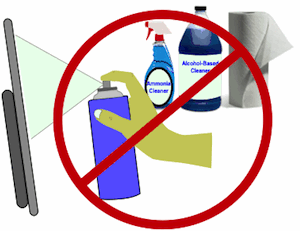How to Clean a Flat Screen
by: Dale Cox

To clean a flat screen, whether it's a TV, laptop monitor, tablet touch screen or smartphone, use the same approach. Remove dust with a clean microfiber cloth, and for oil and other smudges, wipe with a bit of distilled water and white vinegar.

First, Some Don'ts
Cleaning today's high tech TV's and monitors using traditional methods of spraying and wiping will quickly turn your very beautiful hi-def screen into a spotty, blurry mess from which there is no return.
To avoid a disaster like that, DON'T DO the following:
- Don't spray liquid directly onto the screen, it will seep under the display layers and cause large, permanent black spots
- Don't use household cleaners that contain ammonia or alcohol, they will damage the screen, not clean it
- Don't use paper towels or other wood-based cloths, they will leave tiny scratches on the screen that will accumulate with each use and over time, blur the screen
- Don't rub the screen with hard pressure and never in circles, this can leave permanent marks on the screen
- Don't use cleaning rags used for other things, use a microfiber cloth only and wash it frequently
- Don't touch the screen unless you have to, touch screens being the obvious exception here
Best Flat Screen Cleaning Methods
Cleaning a flat screen should be done using the most minimally invasive steps first and then moving on to more stringent methods if needed to remove tough oils, etc. Use the following cleaning methods starting with the first and moving on if needed:
- Turn off the screen and let it cool, don't clean a warm or hot screen
- Remove the dust
- Wiping will usually be all that's needed here. Use a microfiber cloth and lightly wipe in complete strokes, either vertically or horizontally, across the whole screen
- Fold the cloth in quarters and turn to a clean layer as it collects dust.
- With extra large screens, use more than one cloth.
- If you have excessive dust on your screen and you're just spreading it around, try blowing it off. A can of compressed air works well for this, be sure to keep the can upright at all times and don't allow propellant to spatter onto the screen
- A hairdryer on the NO HEAT setting can work for excessive dust. DON'T ever use the hot setting, this could damage the screen
- For tough oily marks use a cleaning liquid
- Mix a 50/50 solution of distilled water and white vinegar
- Lightly dampen a corner of the microfiber cloth with the solution
- Gently wipe the oily spots with the damp corner using wide, back and forth strokes
- Repeat with another clean corner on the cloth if necessary
- Gently remove any excess fluid using a dry area of the cloth
- Allow the remaining moisture to air dry

Cleaning Your Touch Screens
With all that touching, you're going to have to clean your touchscreen more frequently than the other flat screens in your life. Finger oils, dust, scratches, and even UV from the sun can affect the screen's functionality and performance.
- Keep the screen covered whenever possible to minimize dust and UV exposure. This is easy with a laptop but a smartphone will be harder to protect. A screen protector is a good accessory to prolong the life and beauty of your smartphone screen
- Wash your hands frequently and especially before you use the touchscreen
- To clean your touchscreen, use microfiber cloth recommended to clean other screens. Wipe gently in horizontal strokes and then use vertical strokes
- If you need more power, dampen the cloth with 50/50 distilled water and white vinegar
- Microsoft® also recommends using eyeglass cleaner when a dry cloth won't do the job
- Apple® recommends iKlenz for tough jobs